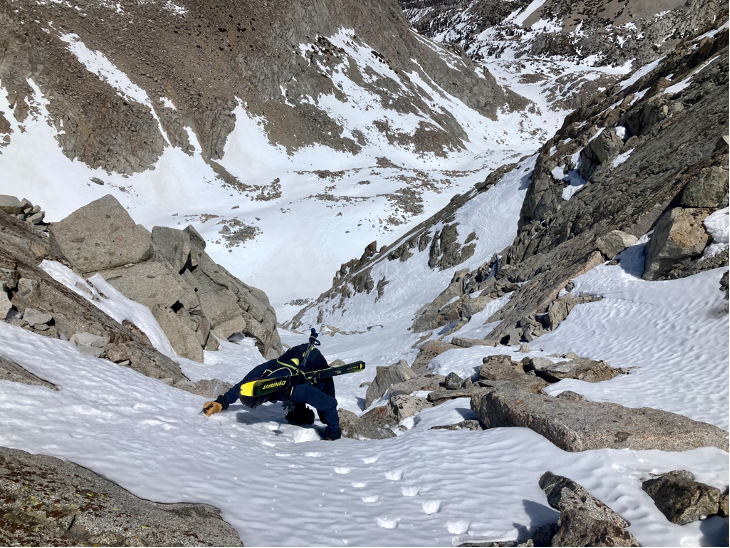Dropping in below the Pearly Gates (April 22) (Photo: Wes Bochner)
Editor’s Note: This article is summary of a few of Evoke Endurance coach, Jack Kuenzle’s ski FKTs (Fastest Known Time) done in 2022. You can listen to more of Jack’s story on the EvokeCast.
The aim of this article is to describe the preparation, training, and experiences I had while preparing for and racing backcountry ski mountaineering efforts on Mount Tallac, Shasta, and Hood during the 2021-2022 season. There are also passing references to me running Mount Shasta for time (4/1/22). I conducted all high intensity training for these efforts on a stairmaster or incline treadmill, a link to my workouts is at the bottom.
Training
Winter 21/22, my training was primarily focused on preparation for mountainous ultra trail efforts during summer 2022. I wanted to have an off season and intentionally placed ski objectives at a lower priority versus trail running. With this in mind, I talked to Scott Johnston and he recommended executing a large amount of Z1 volume on skis, coupled with a once per week, steady state muscular endurance workout and a hill sprint (8-20 second intervals) workout. He also recommended including some running work, even if it was just once per week. I did not do any speed work on skis. I didn’t want to tie myself to locations with suitable terrain for hill sprints, so I cut that from the schedule. I figured if my fitness worked out and applied to some ski objectives, that would be a bonus.

Pausing before a transition on Whitney’s Mountaineers Route (February 22) (Photo: Kate Hamilton)
Between December and April, I climbed over 900,000 vertical feet skiing. I estimate about 30,000 feet of that was in a resort, the rest was in the backcountry, 95% of it solo. Part of this was building a base for summer work, but, having only logged 250,000 feet of backcountry skiing prior to the 2021-2022 season, I needed to build the skills to race these objectives. I trained primarily in race boots with race bindings and a race adjacent pair of skis (Dynafit Blacklight 74 158 cm). I had to learn how to ski a race setup effectively, how to build an efficient skin track, when to transition between skinning and booting, transitioning quickly, booting up and down steep terrain quickly, etc and needed to ski hundreds of hours to become remotely proficient in any of these areas.
For specific muscular endurance training, I conducted all work indoors on either a stairmaster or incline treadmill. I find training on machines to be extremely effective, there are no issues of inconsistent grade, poor traction, poor weather, or route finding to slow one down. Further, most variables can be controlled and workouts can be easily compared. December, January, and February, I executed weighted hikes on the stairmaster. Length of work was always sixty minutes and I varied pack weight between 30 and 70 pounds. In March, with eyes on an upcoming running attempt on Shasta and ski attempt on Hood, I switched to slightly higher intensity, unweighted Zone Three interval work on the treadmill.

Downclimbing the entrance to the North Couloir on Mount Johnson (April 22) (Photo: Nathan Longhurst)
Acclimatization
The only reason I felt comfortable racing against Jason Dorais, Alex King, Tom Goth, and Ryan Ghelfi was because I knew I could spend more time acclimatizing higher than they did. Jason and Tom live in Salt Lake City at around 4500 feet, Ryan and Alex in the Pacific Northwest at less than 2000 feet. December to February, I slept in Tahoe at a Snopark at 7400 feet. After racing Shasta on skis, I realized the importance of sleeping as high as possible, so I spent March and April in the Eastside sleeping between eight and nine thousand feet. Additionally, in the Eastside, I was able to ski terrain over 14,000 feet. Due to my high training volume, I was probably spending at least four hours every day above ten thousand feet.

Skiing in the Eastside, an unnamed peak and Treasure Benchmark Peak in the distance (March 22) (Photo: Author)
I made an effort to always conduct high intensity training lower than I slept. Fiscally and environmentally, it wasn’t always possible to drive much lower, but I primarily did workouts at 6000 feet in Tahoe and 4000 feet in Bishop. Prior to running Shasta, I did two workouts in Mammoth Lakes at 8000 feet. While this is against traditional “sleep high, train low” wisdom and the training effect on the musculature would be reduced, I felt training at altitude would be relevant for racing at higher altitude and, perhaps, some adaptations to my respiration and vascular system may be sparked by the high intensity work in the thin air. These were some of the hardest workouts I’ve ever done.
Conditions
Conditions are an enormous factor for backcountry skimo racing. Because these speed efforts are unorganized, it’s possible to wait an entire season for perfect conditions. From personal experience, this is by far the worst part of these efforts. Some mountains won’t come into race condition all year, I estimate Shasta was never in “perfect” conditions this year. Snow can be too soft and powdery and unsuitable for fast times uphill. Snow could carry a breakable crust that may make descending at speed impossible. Mountains like Mount Hood get less steep as more snow accumulates on their upper slopes, making speed attempts easiest and safest late in the season. Terrain in the PNW has the tendency, especially at the highest elevations, to get blasted by the wind and coated in rime ice. Sometimes this ice can make ascending or descending slow, other times extremely dangerous. There are human factors also, such as the presence of a good boot pack or skin track or horrible postholing.

Climbing up an excellent bootpack on Mount Hood (April 22) (Photo: Tyler Dille)
Hood and Shasta are very similar, so I could apply lessons regarding conditions from one mountain to the other. Both are volcanoes at similar altitudes and similar distances from the coast. Both are south facing climbing lines that are generally subject to similar winds. Both receive a large amount of human traffic. Both are typically skied on a wet/corn snow melt layer. As a result, whenever I skied either (or similar south facing lines on wet layers) I would take a screenshot of the weather and save it in my notes along with my tour start time and general notes about conditions. It’s critical not only to pick the right day to race, but to start at the right time and bring the correct equipment for the conditions and no more.
Equipment
Beyond some pro deals, I don’t have a financial relationship with any gear manufacturer and have no intentions of developing a relationship with a gear manufacturer. All of the gear used was purchased full price, unless stated otherwise.
Skis: Aski Stealth (Tallac, Shasta) (160 cm 65 mm)
Ski Trab Gara Aero World Cup (Hood) (162 cm 64 mm 60 flex)
I think there is a good argument for racing backcountry objectives on a race adjacent ski. A Dynafit Blacklight Pro is only slightly heavier but considerably wider and more durable. Uphill may be slightly slower but the downhill may be much faster.
Bindings: Ski Trab Titan
Had one of these bindings come off of my boot three times while skinning up Shasta and additional three times while skinning up Hood. Will be reaching out to Trab. Otherwise, it performed fine.
Boots: Scarpa Alien 1.0
Best piece of equipment I’ve ever used. Fantastic performance on the up and down. I was concerned about durability and went with a half carbon boot, but I lost some time here due to the additional weight.
Bag: Dynafit DNA 16
Crampons: Petzl Leopard
Awesome piece of gear. I removed the ankle keeper to speed up transitions.
Axe/Tool: Black Diamond Carbon Whippet (Shasta)
Petzl Gully (Hood)
Not a fan of the Whippet. It’s a poor ice axe and weighs as much as a skimo race pole and a lightweight axe, together. Whippet needs to be lighter, otherwise you’re better off Voile strapping a real axe to your skimo race poles.
Poles: Black Diamond Carbon Razor (Purchased using military pro deal) (Tallac, Shasta)
Dynafit Speed Pole (Hood)
Prior to Hood, I wasn’t aware how much lighter skimo race poles are versus carbon touring poles.
Helmet: Black Diamond Vapor (Purchased using military pro deal)
Jacket: Patagonia Houdini (Shasta)
Communications: Garmin inReach (Shasta)
Base layers: Compression underwear or variation
Tank top (Tallac)
After reading some research regarding muscular contractions being limited by overheating, I decided to make staying cool a priority for my race efforts. Heat production is far greater in larger athletes (I am 74” 180 lbs) so I felt this was especially relevant to me.
Race Report: Mount Tallac
Date: 1/26/22
Previous Round Trip Record: Unknown
My Ascent: 46:00
My Roundtrip: 53:55
Elevation gain: 3,240 feet
Strava: https://www.strava.com/activities/6586682309
This season, Tahoe and Shasta received a record amount of snow in December and, then, virtually no snow in January and February. Come late January, the ski routes on Tallac were melting out and I became concerned it wouldn’t be in condition later in the season. Instead of racing the traditional route up the mountain up the northeast ridge, I laid a skin track and boot pack up the northeast bowl (this line is usually ascended in the spring). This line is more direct and doesn’t involve as much traversing, but does involve bootpacking (I think in perfect conditions it may be possible to skin the northeast ridge to the summit without removing one’s skis). This route involves about 3200 feet of climbing, 2200 feet of that skinning and 1000 feet bootpacking. I raced the route primarily on windboard but on some corn down low. I failed to establish a good skin track within the bowl and had to do some technical edging on hard snow. Beyond that, besides coming extraordinarily close to crashing at the end, this attempt was uneventful.

Post Tallac speed lap (January 22) (Photo: Author)
Race Report: Mount Shasta
Date: 2/8/22
Previous Round Trip Record: Unknown
My Ascent: 2:05:48
My Roundtrip: Incomplete
Elevation Gain: 7,410 feet
Strava: https://www.strava.com/activities/6653121048
Similarly to Tallac, I became concerned that Shasta wouldn’t be skiable later in the season. In early February, the mountain was in good condition, save some challenging rime ice on Misery Hill 13200-13800 feet on the mountain. On a higher snow year, it is possible to drop briefly on to the east face of Misery Hill and circumvent the rime ice, but in early February this area was too rocky. The traditional Avalanche Gulch climbing route runs looker’s right of a raised rocky feature called the “Heart” and climbs through a largely horizontal ridge of rock, the “Red Banks”, on the right side of the south face. This route involves some traversing and is slower than climbing to the left of the Heart and circumventing the Red Banks on its left side. This variation is commonly done by skiers. In early February, there wasn’t a boot pack on this section of the route, so I went up three days prior and did a couple of laps between the top of the skinning at 11,000 feet and the top of the steep boot packing at the base of Misery Hill, 13,200 feet. Above there, the snow was so firm and wind blasted a boot pack was not necessary.

Shasta from the Bunny Flat trailhead (March 2020) (Photo: Author)
For my speed attempt, I decided to wear long underwear I had cutoff just below the knees, no shirt or gloves, and carry a lightweight windbreaker in case I needed it up high. I knew this was risky, mainly in the event of a fall, but I felt I could execute safely. I wore similar kit on Hood and Tallac, but the remoteness and greater potential for a long fall on Shasta gave me pause. I also carried an emergency blanket and an inReach. In hindsight, a pair of gloves would have weighed little and vastly increased my ability to manipulate my equipment in cold conditions. They would have been worth bringing.

Safely down at the bottom post speed attempt (February 22) (Photo: Author)
Race day at 12,750 feet the forecasted high was 23 degrees and winds were north northeast 16 to 18 mph gusting to 28. The bottom 1000 feet of the route through the forest was in horrible condition. It was extremely postholed, suncupped, and littered with pine boughs and needles. I fell multiple times attempting to ski run this section. From the base of Avalanche Gulch proper to the summit, I enjoyed close to perfect ascending conditions. There wasn’t a skin track (intense solar heating melts all but the deepest skin tracks) but the snow was both soft and supportive enough to allow for fast movement. My toe binding on one ski failed and my ski popped off three times on the skin. The initial ski off the summit went perfectly, but on the first hard turn on Misery Hill, my skis both tip to tail delaminated and snapped in half. The hard chatter on the rime ice baby/chicken heads destroyed the fragile skis in seconds. My thumb was cut by the ski edge and I had to quickly get my crampons back on before the cold made my hands unusable. I cached the skis at 13,000 feet and descended the traditional climbing route uneventfully.

Aftermath (February 22) (Photo: Author)
Race Report: Mount Hood
Date: 4/24/22
Previous Ascent Record: 1:23:41 (Alex King, running)
My Ascent: 1:16:40
Previous Roundtrip Record: 1:44:03 (Jason Dorais, skis)
My Roundtrip: 1:31:31
Elevation Gain: 5,380 feet
Strava: https://www.strava.com/activities/7035372894
Hood was extremely challenging from a conditions perspective. In January, I came to the mountain with the intention to attempt a speed record. An initial scouting mission found challenging waterfall ice conditions in the Pearly Gates, a steep, fairly narrow ice chute 200 feet below the summit. Downclimbing this section was challenging even with two tools and aluminum race crampons. I found that as snow accumulates on Mount Hood, the slope of the upper mountain becomes less steep and, generally, less icy. In late March I determined there was likely enough snow for a record attempt, but poor weather persisted until the end of April. I was in Mammoth Lakes at the time, a 13 hour drive away, and I knew I had to get the weather window right if I was committing to such a long drive. A three day window emerged (Friday-Sunday, although weekends are not ideal due to human traffic on busy climbing routes) and I drove up.
Scouting the route on Friday I encountered generally soft and powder conditions. Due to the recent snow, the upper mountain had received more than ten feet in April alone, there was no skin track and barely a bootpack on the upper mountain. A wind event Friday night transformed the mountain to breakable windboard. Saturday the weather was passable but I resolved to wait until Sunday to maximize melting and route development. On Sunday, the forecasted high was 38 and winds were south southwest 7 to 14 mph, gusting to 21. These conditions would have led to very soft snow on Mount Shasta, but little melting occurred and conditions remained windboard into Sunday morning. I resolved to wait as long as I could to maximize melting, but not so long that the snow became soft and punchy and falling ice prevented ascending above the Hogsback (10600 feet) (end of skinning and beginning of steep bootpacking).

Heading up into the Pearly Gates (April 22) (Photo: Wes Bochner)
The actual attempt went well. I had the same issue with the toe piece of one binding failing three times on the skin. The first half of this route travels on a groomed track through a ski resort. Above the highest chairlift, the skin track was intermittent and extremely postholed at times. This was the worst part of the route. At the Devil’s Kitchen fumarole (10200 feet), a good skin track led to the top of the Hogsback. There I transitioned from skinning to booting with poles until the base of the gates, where I drew my ice axe and ascended to the summit. I had two friends staged at the base of the Pearly Gates to hold traffic and keep route chokepoints clear. Despite this there was a single climber lodged in the tightest possible location on the route, he let me pass both ascending and descending but it was tight. Whereas in January I was forced to face in downclimbing from the summit to the top of the Gates, the lower angle and good snow conditions allowed me to run this section. Remembering my attempt on Shasta, I knew I had to take the ski down conservatively and I skied it only marginally faster than I would have on a casual lap. Despite this, I punched through the windboard three times and almost fell. Once I crossed into the resort, the conditions were very fast back to the start.

Done (April 22) (Photo: Author)
Closing
In many mountain sports, I think there is a tendency among U.S. athletes to look to Europe and to base the evolution of sport here around the trajectory of sport there. I think skimo racing is an example where the U.S. has opportunities for racing that may not exist in Europe. The volcanoes of the PNW provide a fantastic arena for competition. They are extremely prominent, the snow lines are relatively low, snow conditions are largely stable and safe, and mountain access is generally easy. I think there are many suitable locations for backcountry ski mountaineering racing beyond the volcanoes, but I think these mountains are ideally suited for it. On the other hand, versus traditional skimo racing, backcountry skimo racing can be extraordinarily frustrating as ideal conditions are both elusive and enormously important to one’s finishing time. Right now, in the United States, I am only aware of publicized, competitive ski records on Mount Rainier, Mount Denali, and Mount Washington (New Hampshire), beyond the mountains discussed in this article. I’m excited to see how the sport develops and speed skiing culture and efforts spread to other objectives.
Link to speed work: https://docs.google.com/document/d/12AcYcLL83fpTt1e6a5nCatiwMC5l69325V-nbPVmsuA/edit















[…] Speed Efforts in Backcountry Skiing: Endurance coach Jack Kuenzle highlights some of the best backcountry ski mountaineering feats of the year and what it took to accomplish them. […]